The GIGABYTE Z170X-Gaming G1 Review: Quad-SLI on Skylake, and now with Thunderbolt 3
by Ian Cutress on December 1, 2015 9:30 AM EST- Posted in
- Motherboards
- Gaming
- Intel
- Gigabyte
- PLX
- PLX8747
- Z170
- Thunderbolt 3
System Performance
Not all motherboards are created equal. On the face of it, they should all perform the same and differ only in the functionality they provide - however this is not the case. The obvious pointers are power consumption, but also the ability for the manufacturer to optimize USB speed, audio quality (based on audio codec), POST time and latency. This can come down to manufacturing process and prowess, so these are tested.
Power Consumption
Power consumption was tested on the system while in a single MSI GTX 770 Lightning GPU configuration with a wall meter connected to the OCZ 1250W power supply. This power supply is Gold rated, and as I am in the UK on a 230-240 V supply, leads to ~75% efficiency > 50W, and 90%+ efficiency at 250W, suitable for both idle and multi-GPU loading. This method of power reading allows us to compare the power management of the UEFI and the board to supply components with power under load, and includes typical PSU losses due to efficiency. These are the real world values that consumers may expect from a typical system (minus the monitor) using this motherboard.
While this method for power measurement may not be ideal, and you feel these numbers are not representative due to the high wattage power supply being used (we use the same PSU to remain consistent over a series of reviews, and the fact that some boards on our test bed get tested with three or four high powered GPUs), the important point to take away is the relationship between the numbers. These boards are all under the same conditions, and thus the differences between them should be easy to spot.
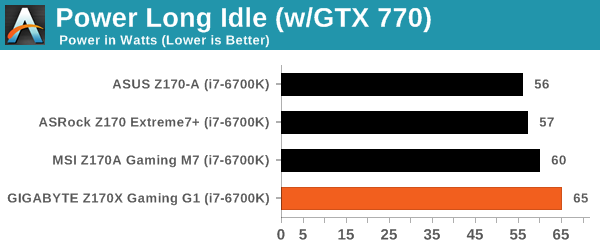
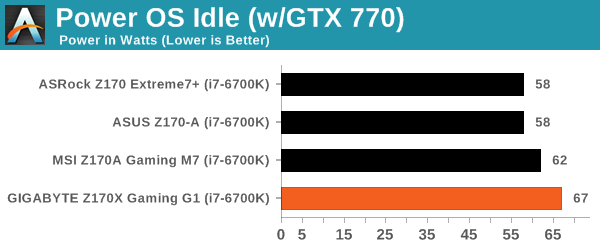
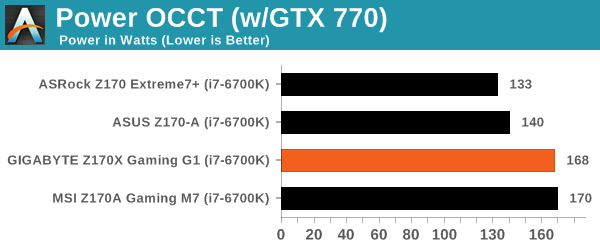
GIGABYTE’s Z170X-Gaming G1 implements MultiCore Turbo with K-series processors by default, which seems to require an extraordinary amount of voltage when at stock frequencies (1.404 volts at load). This translates into a large power consumption at stock, which can be mitigated by some manual adjustments. For example, our 4.7 GHz overclock saw 1.392 volts at load at 73C max temperature for only 167W total system power draw.
Non UEFI POST Time
Different motherboards have different POST sequences before an operating system is initialized. A lot of this is dependent on the board itself, and POST boot time is determined by the controllers on board (and the sequence of how those extras are organized). As part of our testing, we look at the POST Boot Time using a stopwatch. This is the time from pressing the ON button on the computer to when Windows 7 starts loading. (We discount Windows loading as it is highly variable given Windows specific features.)
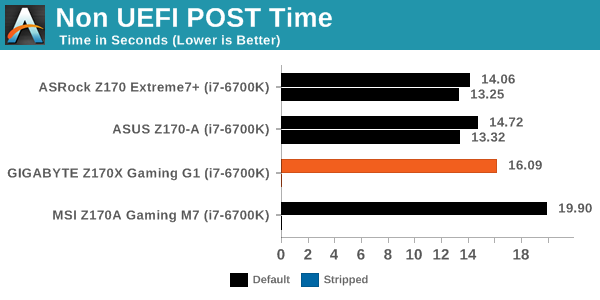
The BIOS we tested was more of an early beta BIOS, but even then the G1 comes with a large number of extra controllers that need to be checked at POST which adds on to the non-UEFI POST time. That being said, 16 seconds or so comes out well enough, but the ‘stripped’ POST time seemed to go awry.
Rightmark Audio Analyzer 6.2.5
Rightmark:AA indicates how well the sound system is built and isolated from electrical interference (either internally or externally). For this test we connect the Line Out to the Line In using a short six inch 3.5mm to 3.5mm high-quality jack, turn the OS speaker volume to 100%, and run the Rightmark default test suite at 192 kHz, 24-bit. The OS is tuned to 192 kHz/24-bit input and output, and the Line-In volume is adjusted until we have the best RMAA value in the mini-pretest. We look specifically at the Dynamic Range of the audio codec used on board, as well as the Total Harmonic Distortion + Noise.
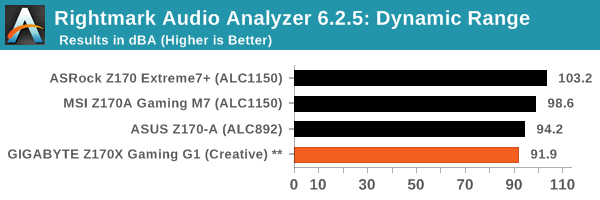
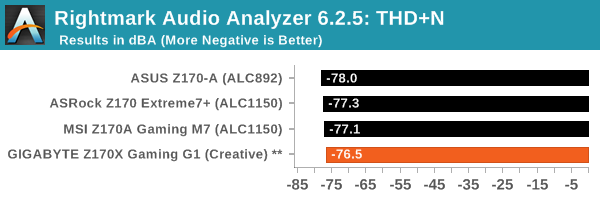
As we’ve known in the past, audio is difficult to test outside of Realtek operations mainly due to the extra ‘enhancements’ offered by certain software packages that refuse to completely turn everything off. As a result, the GIGABYTE numbers seem low for what they should be, but this is usually some software tool always enabled that interferes with out result.
USB Backup
For this benchmark, we transfer a set size of files from the SSD to the USB drive using DiskBench, which monitors the time taken to transfer. The files transferred are a 1.52 GB set of 2867 files across 320 folders – 95% of these files are small typical website files, and the rest (90% of the size) are small 30 second HD videos. In an update to pre-Z87 testing, we also run MaxCPU to load up one of the threads during the test which improves general performance up to 15% by causing all the internal pathways to run at full speed.
Due to the introduction of USB 3.1, as of June 2015 we are adjusting our test to use a dual mSATA USB 3.1 Type-C device which should be capable of saturating both USB 3.0 and USB 3.1 connections. We still use the same data set as before, but now use the new device. Results are shown as seconds taken to complete the data transfer.
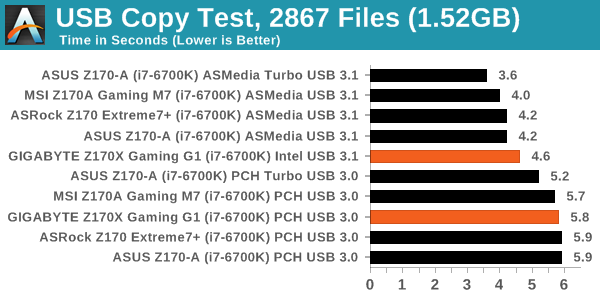
As a first look into the Alpine Ridge controller, the USB speeds for our transfer were a little down compared to the motherboards with the ASMedia, but in our case this also translates to Thunderbolt 3 being in this port as well. Unfortunately we do not have any TB3 devices to test it with at the minute.
DPC Latency
Deferred Procedure Call latency is a way in which Windows handles interrupt servicing. In order to wait for a processor to acknowledge the request, the system will queue all interrupt requests by priority. Critical interrupts will be handled as soon as possible, whereas lesser priority requests such as audio will be further down the line. If the audio device requires data, it will have to wait until the request is processed before the buffer is filled.
If the device drivers of higher priority components in a system are poorly implemented, this can cause delays in request scheduling and process time. This can lead to an empty audio buffer and characteristic audible pauses, pops and clicks. The DPC latency checker measures how much time is taken processing DPCs from driver invocation. The lower the value will result in better audio transfer at smaller buffer sizes. Results are measured in microseconds.

The DPC Latency on the G1 is clearly unoptimized at this point, or might be a victim of having a large number of controllers involved. Some manufacturers at this point would suggest ‘well, you need XYZ setting’, but then it becomes a game of ‘hunt the needle’ trying to get the best DPC Latency value. In that context, this is why we always say we test the out-of-the-box value, which is what most people are going to experience, rather than a few hours fiddling with BIOS options to squeeze out that extra microsecond to say one is better than the other.










67 Comments
View All Comments
Questor - Monday, December 28, 2015 - link
I am not sure why so many motherboards are including the Killer LAN for the networking. The split second I read that, this motherboard fell to a $0.00 price point. I hate and by hate, I mean HATE Killer LAN networking solutions. One of my X99 boards and an ASRock 990FX have Killer LAN and neither implementation performs worth a fudge. The Intel solution on my other X99 (R5E), M5A99FX Pro R2.0 (B3) and the Realtek on my P67 board are faster, easier to deal with and never disconnect from anything or experience failure to load, latency issue, etc., unless my ISP itself is having problems. Killer has pushed my patients past the limit more than once. I am beginning to consider anything with Killer involved and reference to gamer or gaming to be like the horrid quality TN panels pushed off on the gaming public. A lesser class of product. Give me an Intel NIC and leave me in my heaven. I load the drivers and they just work; never have to mess with them again!__187__ - Wednesday, January 6, 2016 - link
first of all, u have enough lanes for quad sli because u have 16 lanes for the graphics card coming from the cpu and another 20 coming from the chipset via dmi. Makes atotal of 36lanes u could split up.Whats normally not working out are multiplexing chips, if it splits up without errors u left with the performance decrease. So at quad sli u left with 4 lanes for everything else, m2ssds/usb3.0chips/killer nics etc etc
That brings us to the weak spot of this test. The only thing whats different from other boards is entirely not tested. Pls make this thing full with gpus and m2 ssds etc and test if this multiplexing works out. Should be possible tou to get 4 identical gpus, im sure gigabyte got some lying around. If not ask asus if they help u prove that the new gigabyte board is crap. Im sure u got 4 gtx 980ti tomorrow.
Keep in mind that this 500buck board loses every gaming benchmark against a 100buck asus board with one third the phases.
Next joke is the connection of the vrm coolers for water. What is this a 6mm outer diameter pipe? Thx for leaving 10% of my waterflow. Make it 2mm next time.
Is it prefilled or is it an empty "heat"pipe on aircooling?
Next problem is that a dual sli of 980ti's gets limited from a 5820 or 5930 sometimes.
So how much ln2 do i need gigabyte for not bottlenecking a quad sli?
Total bs. And nobody should put together a 960 or whatever quad sli, not even a normal sli if its not really needed. The poor scaling(not a major thing at dual but at triple and quad) is a nightmare, then u got micro stuttering, driver issues and heat/space problems.
If needed ahigh end card dual sli but everything else is wasted money. Wait till next year when pascal and polaris are coming.
Even if the money doesnst care, i would rather go in the next pub and spend the 400bucks there than throwing it away like this
__187__ - Wednesday, January 6, 2016 - link
and it has also worse sound quality, boot time, usb3.1 performance and dpc latency.This must be a joke for 5 times the price.
Also a joke is that at doesnt test the oc ability of this oc board.
__187__ - Wednesday, January 6, 2016 - link
and its recommended by anand so its the third joke in a row.Not tested properly and poor performance in combination with high power consumption gets u an recommended. omg
__187__ - Wednesday, January 6, 2016 - link
But the truth is, gigabyte dont uses the 36 lanes that are possibel, instead they are telling just sthg. as u can see in the link gigabyte brings to us the wonder of splitting up 16lanes into 4 times 8, get u some of that. So they leave the most of the 20 chipset lanes untouched but u only have troubles with ur gpus not the m2 ssds ;)http://techreport.com/review/29346/gigabyte-z170x-...
some wild switching and multiplexing going on there.
Buyers pls dont expect that this hell of a build will run fine anytime soon.
__187__ - Wednesday, January 6, 2016 - link
instead of that ur m2 ssds will throttle because they are crammed(not sure if its the right word) under the gpus, lol__187__ - Wednesday, January 6, 2016 - link
but no, m2 ssds already throttle even if no gpu is installed. gj gigabyte.the likes are: fan header amounts, lighted shield if its dimmable, better socket, full black pcb, dual bios and for a few upgradeable audio.
Next time f.e. better make the wlan module socketed to a chinch or coaxial spdif interface card instead of a second killer nic and put 2 vrm coolers in the box. both together doesnt work out very
well. or just 3 adjustable 40-60mm fans side by side angled upwards pulling to the rear fan of manycases. then just half the phases all on left side connected with good tim and there u go with ur better thermal solution. Then customer can remove the fan package and screw on an adapter for water cooling if needed. fins go over to passive mode. Or let the chassis intrusion switch switch on some white leds on the mobo for checkups.
Just in case someone of gb reads this and u guys wanted to do 3 killer nics on next mobo just ask us what would be nice, im sure u get plenty of ideas from there.